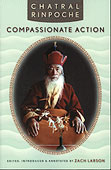|
Kyabje
Chatral Sangye Dorje Rinpoche, also known as Chetul Sangye Dorje*,
was one of the few living disciples of the great master Khenpo Ngagchung
and is widely regarded as one of the most highly realized Dzogchen
(Zogpachenpo) yogis. In addition to his relationship with Khenpo
Ngagchung, Chatral Rinpoche also studied with some of the last century's
most renowned masters, including Dudjom Rinpoche, Jamyang Khyentse
Chokyi Lodro, and the famed dakini Sera Khandro.
Chatral
Rinpoche was the heart disciple and Vajra Regent of the late Dudjom
Rinpoche and the chief lineage holder for three main traditions
in the Nyingma School: Dudjom Tersar, Sera Khandro and Longchen
Nyinthig and in particular the lineage that descends through Jigme
Lingpa's heart son Jigme Gyalwe Nyugu and then on to Patrul Rinpoche
(see
video).
His
greatness was first revealed in the 1930's when his root teacher
Khenpo Ngawang Palzang, author of A Guide to the Words of My
Perfect Teacher, told a large assembly that "his realization
is no different from mine." On the recommendation of his teacher,
he became the head spiritual master for Regent Reting, the political
ruler of Tibet, in 1947. The huge amount of attention drawn to him
through this prestigious position was a distraction for his practice,
and he soon retreated back to the mountains where he spent the next
several years in solitary meditation until he reached the highest
state of realization. This is how he acquired the name "Chatral"
meaning "hermit".He traveled from Tibet to Bhutan in 1958
and constructed the first Longchen Nyinthig retreat center outside
of Tibet a year later in Sikkim. He
Rinpoche was a ngakpa who has consistently shunned institutional
and political involvement, choosing instead whenever possible to
live the life of a wandering yogi ceaselessly working to overturn
samsara for all sentient beings. For many years in Tibet, Chatral
Rinpoche meditated alone in caves and was renowned as a realized
yogi. From the outset Rinpoche chose whenever possible always to
walk on foot, declining the use a horse. He preferred always to
stay in caves, hermitages or in a small tent, never wishing to accept
the invitation of wealthy patrons to stay in the their house. Until his paranirvana
he stayed in his own small place in Parphing
Nepal near a sacred site of Guru Padmasambhava who founded Buddhism
in Tibet. He was married to Kamala and had two daughters, Tara Devi
and Saraswati.
Although
he had never traveled to the West, his amazing story and teachings
have gradually been infiltrating the Western Buddhist consciousness
since Father Thomas Merton first met him in 1968 and famously remarked
that he was "the greatest man I ever met."
Opponent of meat eating
During his life Chatral Rinpoche was one of the most vocal opponents of meat eating
in Tibetan Buddhism.
He says:
If you take meat, it goes against the vows one takes in seeking
refuge in the Buddha, Dharma and Sangha. Because when you take meat
you have to take a being’s life. So I gave it up.
Source: Compassionate
Action, chapter 2 [download
PDF- 145 KB]
Meat, the sinful food, is not permitted according to the three
vows: the vows of individual liberation, the Bodhisattva vows and
the tantric vows. Thus Buddha stated: “I have never approved,
do not approve, and will never approve of a meat diet.” He
declared: “my followers must never eat meat.”
Source: Compassionate
Action, chapter 3 [download
PDF- 183 KB]
Rinpoche considered that becoming a vegetarian can be a gradual path.
Many of his students do not eat meat, fish and egg, nor drink alcohol,
but some of them do.
There are lamas who eat meat and those who don’t. At my
monastery in Tibet there are also lamas who take meat and those
who don’t.
Source: Compassionate
Action, chapter 2
[download
PDF - 145 KB]
Chatral
Rinpoche also released large amounts of fish**
from the Calcutta fish markets every year (see video
recording 2002 and video
recording 2004). Rinpoche composed a song about this practise
of saving lives, tsethar (Ch: fangsheng): Benefits
of Saving Lives [download
PDF- 116 KB]
Fake teachers and students using Rinpoche's name
Unfortuntely the last fiveteen years there are people
in Taiwan and in the USA who misuse the great reputation of Chatral
Rinpoche even to the extend that they built a Dharma centre and
advertise this centre with the name of Rinpoche. Chatral Rinpoche
never gave permission to use his name to promote any Dharma centre
in Taiwan or any Western country. Best is to avoid Dharma
centres or teachers from Taiwan or any Western country promoting
themselves using Rinpoche's name.
See the declaration
by Chatral Rinpoche regarding misuse of his name plus advice
as published at Dudjomba.Org.
• Biography

• High
resolution picture of Chatral Rinpoche
• For more information on the lineage, please see The
Yangsis of HH Dudjom Rinpoche.
• Regarding tshetar see also Lama
Kunzang Drojee
FRENCH
• The
French translation of Tsethar Phan-yon (The Benefits of
Saving Lives) 
*
Within the FWBO also
addressed as Chetrul Sangye
Dorje.
**
Please note that Chatral Rinpoche releases native fish only. To
avoid ecological destruction it is important not to release non-native
species into any
water.
«
Back
|


